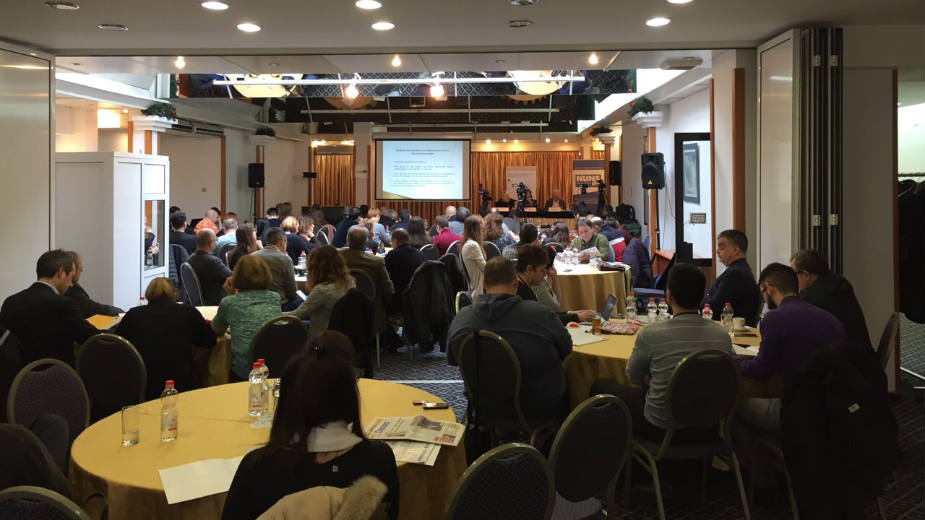
BELGRADE, 30.01.2018. – The Independent Journalists Association of Serbia (IJAS) presented key findings of its latest annual research Indicators on the level of media freedom and journalists’ safety – 2017. The event was closed with the press conference of an international delegation, headed by the European Federation of Journalists that visited Serbia with an aim to determine the level of media freedoms in Serbia.
In the presence of more than 90 journalists, media, media experts and representatives other relevant stakeholders, a day’s conference was opened by Dragan Janjic, IJAS vice president and Andrea Oricio Head of the OSCE Mission to Serbia.
Dragan Janjic highlighted that the physical attacks on journalists have been reduced, but continued to exist in other forms. Janjic assessed that judicial proceedings conducted against journalists last year are “quick and efficient” and concluded that attacks on media by the government and “drawing targets” on individual journalists has significantly increased.
Ambassador Oricio said that journalism is faced with a dilemma about its future: whether it will join the democratic process, interpret the facts putting them in context, checking the statements of public officials or journalists will be entertainers. He said that free and independent media is one of the guarantees of objective and factual reporting, which is a condition for citizens to form their political position in a democratic society.
The key findings of IJAS report, Indicators on the level of media freedom and journalists’ safety – 2017 were presented by researcher Marija Vukasović who said that the freedom of media in 2017 was at a low level and is more limited in comparison to 2016. She highlighted that narrowing of media freedoms has been a noted trend over a longer period of time.
The report shows that one of the major issues in media sphere is the (absence of) work of the Regulatory Body for Electronic Media (REM) – it does not use all legally prescribed possibilities to sanction actions that violate the law, does not publish all documents it is legally obliged to, does not perform monitoring. Also, co-financing of projects in the field of public information for the purpose of achieving public interest is, same as in previous years, faced with numerous problems in practice.
Vukasovic stated that one of the biggest problems is the fact that for a long time now and in a large number of cases, journalists and media workers work in difficult conditions, with very low salaries which are paid irregularly, frequently without signing the labour contract; this especially relates to journalists and media workers who work in local media.
According to the regional database, in the period from 01 September 2016 to 31 August 2017, number of incidents recorded in Serbia amounted to 40, including 8 physical attacks, 28 verbal attacks, one attack against property, two cases of surveillance of journalists, and one of discrimination of media and journalists. The trend from the previous year has continued – the number of physical attacks against journalists and other media workers is decreasing, while the number of verbal attacks via the Internet and social networks has risen.
You can read the whole report here.
Annual Report comprises the findings of research conducted within the regional project Western Balkan’s Regional Platform for advocating media freedom and journalists’ safety, implemented by national organisations of journalists in Bosnia and Herzegovina, Kosovo, Macedonia, Montenegro, and Serbia.
Fact finding mission by EFJ, IPI and SEEMO
The event hosted a press conference by the mission of the European Federation of Journalists (EFJ), International Press Institute (IPI) and South East Europe Media Organisation (SEEMO) that spend two days in Serbia meeting journalists who were intimidated, representatives of national and local media and representatives of the state and state bodies.
“It was encouraging to follow the big interest in Serbia on our fact finding mission. Without any doubt our mission shows that there are a huge need of creating an environment where all journalist by decent working conditions can do their job freely without threats or fear”, Mogens Blicher Bjerregård, president of EFJ said. The mission attracted significant media and official interest, revealed a number of substantial challenges for the promotion of a free, independent and pluralist media environment in Serbia.
During the presentation of their findings, three renowned international organisations stated the following areas as the most worrying and prepared an initial set of recommendations:
- Safety of journalists
- State engagement with media
- Media strategy
- Social dialogue
- Access to information
- Ombudsman
- Definition of a journalist
- Working group on safety
- Press council
To read recommendations for each of the above fields, please see Joint mission to Serbia: our recommendations